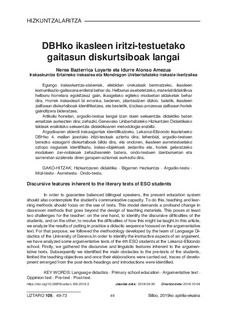| dc.contributor.author | Amezua, Alonso | |
| dc.contributor.other | Bazterrica Loyarte, Nerea | |
| dc.date.accessioned | 2022-09-16T10:23:36Z | |
| dc.date.available | 2022-09-16T10:23:36Z | |
| dc.date.issued | 2019 | |
| dc.identifier.issn | 1130-5738 | en |
| dc.identifier.other | https://katalogoa.mondragon.edu/janium-bin/janium_login_opac.pl?find&ficha_no=168388 | en |
| dc.identifier.uri | https://hdl.handle.net/20.500.11984/5677 | |
| dc.description.abstract | Egungo irakaskuntza-sistemak, elebidun orekatuak bermatzeko, ikasleen
komunikazio-gaitasuna erdietsi behar du. Helburua asebetetzeko, material didaktikoa
helburu horretara egokitzeaz gain, ikasgelako egiteko moduetan aldaketak behar
dira. Horrek irakasleari bi erronka, bederen, planteatzen dizkio: batetik, ikasleen
zailtasun diskurtsiboak identifikatzea, eta bestetik, i(ra)kas-prozesua zailtasun horiek
gainditzera bideratzea.
Artikulu honetan, argudio-testua langai izan duen sekuentzia didaktiko baten
emaitzak aurkezten dira; zehazki, Genevako Unibertsitateko Hizkuntzen Didaktikako
taldeak eraikitako sekuentzia didaktikoaren metodologia erabiliz.
Argudioaren alderdi irakasgarriak identifikatzeko, Lekaroz-Elizondo ikastetxeko
DBHko 4. mailan jasotako iritzi-testuak aztertu dira; lehenbizi, argudio-testuen
berezko ezaugarri diskurtsiboak bildu dira, eta ondoren, ikasleen aurretestuetako
oztopo nagusiak identifikatu, irakas-objektuak zedarritu eta, horiek gelaratzeko
moduluen zer-nolakoak zehaztearekin batera, ondo-testuen izenburuetan eta
sarreretan azaleratu diren garapen-aztarnak aurkeztu dira. | eu |
| dc.description.abstract | In order to guarantee balanced bilingual speakers, the present education system
should also contemplate the student’s communicative capacity. To do this, teaching and learning methods should focus on the use of texts. This model demands a profound change in
classroom methods that goes beyond the design of teaching materials. This poses at least
two challenges for the teacher: on the one hand, to identify the discursive difficulties of the
students, and on the other, to resolve the difficulties of how this might be taught.In this article,
we analyze the results of putting in practice a didactic sequence focused on the argumentative
text. For that purpose, we followed the methodology developed by the team of Language Didactics of the University of Geneva.In order to identify the instructive aspects of an argument,
we have analyzed some argumentative texts of the 4th ESO students at the Lekaroz-Elizondo
school. Firstly, we gathered the discursive and linguistic features inherent to the argumentative texts. Subsequently we identified the main obstacles to the pre-texts of the students,
limited the teaching objectives and once their elaborations were carried out, traces of development emerged from the post-texts headings and introductions were identified. | en |
| dc.language.iso | eus | en |
| dc.publisher | Udako Euskal Unibertsitatea (UEU) | en |
| dc.rights | © Egileak | en |
| dc.subject | Hizkuntzaren didaktika | eu |
| dc.subject | Bigarren Hezkuntza | eu |
| dc.subject | Argudio-testu | eu |
| dc.subject | Iritzi-testu | eu |
| dc.subject | Aurretestu | eu |
| dc.subject | Ondo-testu | eu |
| dc.subject | Language didactics | en |
| dc.subject | Primary school education | en |
| dc.subject | Argumentative text | en |
| dc.subject | Oppinion text | en |
| dc.subject | Pre-text | en |
| dc.subject | Post-text | en |
| dc.title | DBHko ikasleen iritzi-testuetako gaitasun diskurtsiboak langai | eu |
| dcterms.accessRights | http://purl.org/coar/access_right/c_abf2 | en |
| dcterms.source | Uztaro: giza eta gizarte-zientzien aldizkaria | en |
| local.contributor.group | Berrikuntza eta esku-hartzea gizarte kulturanitz eta eleanitzetan | eu |
| local.description.peerreviewed | true | en |
| local.description.publicationfirstpage | 49 | en |
| local.description.publicationlastpage | 73 | en |
| local.identifier.doi | https://dx.doi.org/10.26876/uztaro.109.2019.3 | en |
| local.source.details | Nº 109, pp. 49-73 | en |
| oaire.format.mimetype | application/pdf | |
| oaire.file | $DSPACE\assetstore | |
| oaire.resourceType | http://purl.org/coar/resource_type/c_6501 | en |
| oaire.version | http://purl.org/coar/version/c_970fb48d4fbd8a85 | en |







